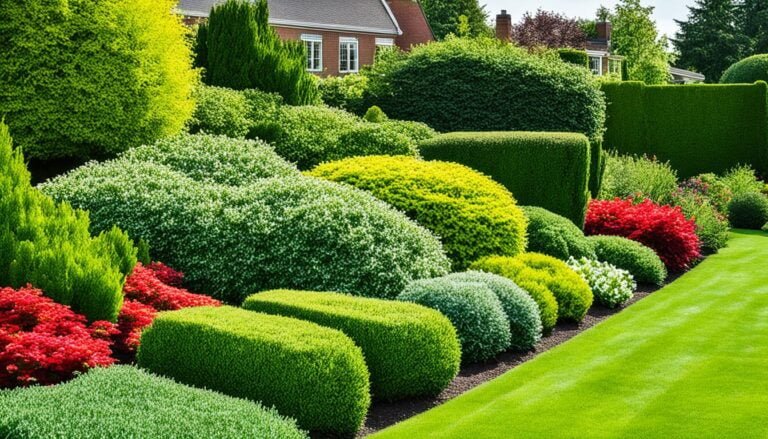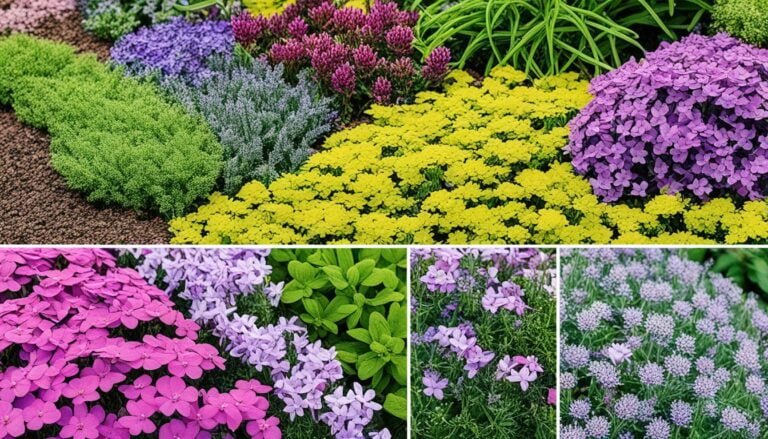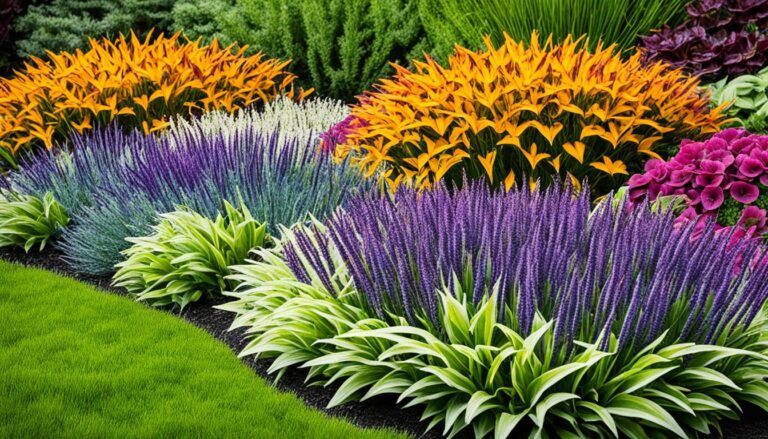Stonecrop Sedum, also known as stonecrop, is a large group of plants in the Crassulaceae family. It has up to 600 species, including annuals, perennials, creeping herbs, and sub-shrubs. These succulents are hardy and easy to care for. They come in many heights, colors, and shapes, perfect for different landscaping uses.
Stonecrop sedums love drought and poor soil. They also have beautiful, evergreen foliage and bright flowers that draw in pollinators.
Key Takeaways
- Stonecrop sedums are drought-tolerant and low-maintenance succulents with a wide range of sizes, colors, and forms.
- They are well-suited for rock gardens, retaining walls, pathways, and other xeriscape landscaping applications.
- Stonecrop sedums feature attractive, evergreen foliage and vibrant blooms that attract butterflies and other pollinators.
- These hardy perennials are deer-resistant and can help with erosion control.
- Stonecrop sedums are versatile plants that can thrive in various growing conditions, making them a great choice for low-maintenance gardens.
Introduction to Stonecrop Sedum
Stonecrop sedums belong to the Crassulaceae family. They are known for their ability to grow well in tough conditions. These hardy perennials come in many species, each with unique foliage colors, textures, and growth habits. They are becoming more popular among gardeners and landscapers.
What are Stonecrop Sedums?
Stonecrop sedums are succulents with leaves and stems that store water. They are found in temperate zones and tropical mountains across Asia, Europe, Northern Africa, and North America. These plants have a long history of changing classification and evolution.
Overview of Sedum Varieties
The Sedum genus includes up to 600 species, now down to 400-500. These plants show a lot of variety, with well-known species in Europe like Sedum acre and Sedum album. Other species include Sedum dasyphyllum, Sedum reflexum, and Sedum hispanicum.
These sedum species are grouped into tribes within the subfamily Sempervivoideae. About 55 European species of Sedum have been identified. They vary in chromosome numbers, often being polyploid.
Over the years, there have been challenges in classifying sedum species. Some suggest moving certain species to other genera. Different classification systems have grouped sedum into sections and subgenera. Berger’s 1930 system and Ohba’s 1978 classification are widely accepted by taxonomists.
Advantages of Growing Stonecrop Sedum
Stonecrop sedums are loved for being low-maintenance and drought-tolerant. They’re perfect for gardeners wanting a beautiful garden with little work. These plants can grow well in poor soil and need less water once they’re settled.
Versatile Landscaping Uses
Sedums are very flexible, with groundcover types great for rock gardens, pathways, and erosion control. Taller sedums work well in container gardens, green roofs, and living walls.
Attractive Foliage and Flowers
Stonecrop sedums also have beautiful, evergreen leaves and bright flowers. These attract butterflies, making gardens more interesting and helping the environment.
Showy Stonecrop is a favorite sedum, suitable for USDA Hardiness Zones 5-10b. It’s great for different climates and regions. Its drought tolerance is perfect for arid conditions, supporting sustainability. Busy gardeners will love its low-maintenance nature.
- It’s best to grow Showy Stonecrop from stem cuttings. This makes it easy to spread and grow more plants.
- Use a cactus mix with perlite or vermiculite for the soil. This helps with drainage and keeps the roots healthy.
- Watch out for pests like slugs, snails, and vine weevil. These can harm your plants.
- Avoid overwatering to prevent root rot. Let the soil dry out a bit between waterings.
Stonecrop sedums are a great choice for gardeners wanting easy, drought-resistant plants. They bring beauty with their leaves, flowers, and many uses. These hardy succulents are a smart pick for any garden.
Choosing the Right Stonecrop Sedum for Your Garden
When picking stonecrop sedums for your garden, think about their growth habits and traits. Groundcover sedums like Sedum album, Sedum spurium, and Sedum ternatum spread out well on the ground, along walls, or in rock gardens.
Groundcover Varieties
- Sedum album (White Stonecrop) does well in zones 3-9 and grows 3-6 inches tall.
- Sedum spurium (Voodoo Stonecrop) fits zones 3-9.
- Sedum ternatum (Wild Stonecrop) is 3-6 inches tall and is good for zones 3-9.
Taller Sedum Species
Taller sedums, such as Sedum telephium, can get up to 2 feet tall. They’re great in mixed borders or containers. Here are some:
- Hylotelephium telephium ‘Autumn Fire’ (Autumn Fire Sedum), best for zones 5-9.
- Hylotelephium spectabile ‘Autumn Joy’ (Autumn Joy Stonecrop), good for zones 3-10 and grows 18-24 inches tall.
Color and Texture Variations
Sedums have many colors and textures, from the bright greens and blues of Sedum Angelina to the deep purples and reds of Sedum Schorbuser Blut. This lets you pick ones that match your garden’s look. Other examples include:
| Sedum Variety | Color and Texture | Hardiness Zones |
|---|---|---|
| Sedum rupestre ‘Angelina’ | Vibrant green foliage | 4-9 |
| Sedum reflexum ‘Blue Spruce’ | Blue-green, sprucelike foliage | 3-11 |
| Sedum tetractinum ‘Coral Reef’ | Coral-pink flowers | 4-8 |
Planting and Care Tips
To grow beautiful stonecrop sedums, it’s important to know their best growing conditions and care. These hardy succulents love well-draining soil to avoid root rot. They can grow in different types of succulent soil, like sandy, rocky, or lean soils. But, keeping the soil well-drained is crucial.
Sedums like full sun to partial shade. Most don’t need a lot of sedum fertilizer. Too much fertilizer can make them weak and long. When watering, let the soil dry out a bit between waterings. Sedums don’t like too much water.
Young sedums need more water to get their roots strong. But once they’re grown, they can get by on rainwater in many places. In winter, cut back on watering to stop rot and let them sleep.
With the right care, these succulents will show off beautiful leaves and flowers all season.
Ideal Growing Conditions
- Full sun to partial shade
- Well-draining sedum growing conditions
- Tolerant of a variety of succulent soil types
Soil Requirements
- Prefer well-draining soil to prevent root rot
- Adapt to sandy, rocky, or lean succulent soil types
- Do not require heavy sedum fertilizer
Watering and Fertilizing
- Allow soil to partially dry out between sedum watering
- Young plants may need more frequent watering to establish
- Reduce watering during winter months to prevent rot
Propagating Stonecrop Sedum
Stonecrop sedums are super easy to spread, perfect for gardeners wanting to grow more or share with loved ones. You can use sedum cuttings or division to grow more plants. Both methods are simple and fun.
To start sedums from cuttings, cut a 2-inch stem from the plant’s tip with a sharp knife or scissors. Take off the lower leaves, then put the cutting in a potting mix or gritty soil. In a few weeks, roots will grow, and you can move it to a new spot.
Dividing sedums is another good way to spread them out. Do this in spring or fall by digging up the plant. Use your hands or a tool to split it into smaller pieces, each with roots. Put these pieces in well-draining soil, and they’ll thrive.
Choosing cuttings or division lets you easily add more sedums to your garden. These plants are tough, need little care, and bring beauty with their leaves and flowers.
| Propagation Method | Timing | Advantages |
|---|---|---|
| Sedum Cuttings | Any time | Less invasive, multiple attempts possible |
| Sedum Division | Spring or Fall | Ideal for overcrowded plants, creates new clumps |
Stonecrop Sedum in Container Gardens
Stonecrop sedums are great for container gardens. They grow low and spread out, making them perfect for small spaces. They also love dry conditions, which is great for planters and hanging baskets.
Choosing the Right Container
When picking a container, make sure it has good drainage. Use terracotta or concrete pots to prevent water from pooling. Sedums fit well in many pot sizes, from small to large.
Combining with Other Succulents
You can mix sedums with other succulents like echeveria, sempervivum, and opuntia. This creates beautiful, easy-to-care-for container gardens. The different shapes and colors look great together.
When planting sedum in containers, use soil that drains well. Water them just enough so the soil dries out a bit between waterings. Sedums can survive if you forget to water them sometimes.
| Container Material | Advantages |
|---|---|
| Terracotta | Porous, allowing for better drainage and air circulation |
| Ceramic | Durable and available in a variety of styles and colors |
| Concrete | Sturdy and weather-resistant, perfect for outdoor use |
Choosing the right container and mixing sedum with other succulents makes for beautiful, easy gardens. These gardens look great and need little care, even in harsh conditions.
Using Stonecrop Sedum in Landscaping
Stonecrop sedums are great for many landscaping uses. They are drought-tolerant and spread out well. These plants can make any outdoor area look better and work better.
Rock Gardens and Retaining Walls
Sedum rock gardens and retaining walls go well together. The sedum rock gardens let these plants flow down slopes and fill in gaps between rocks. They look great and need little care.
Pathways and Stepping Stones
Sedums can soften the look of pathways and stepping stones. As they grow, they fill in gaps, making the area look lush and soft. This makes the space both pretty and useful.
Green Roofs and Living Walls
Sedum is great for green roofs and living walls because they like shallow, well-draining soil. These plants help with stormwater runoff and keep buildings warm. They’re a smart pick for xeriscape projects.
Looking to make a beautiful rock garden, a soft pathway, or a green roof? Stonecrop sedums are a smart and beautiful choice. They can make any outdoor area look great.
Common Issues and Solutions
Stonecrop sedums are easy to care for but can face some problems if not taken care of right. Overwatering is a big issue because sedums can get sedum root rot if the soil stays too wet. It’s key to let the soil dry out a bit between waterings and make sure the soil drains well.
Sedums might also get pests like aphids or mealybugs, or diseases like fungal infections. But, you can usually fix these with good care or organic pest control.
Overwatering and Root Rot
- Sedums can get root rot if the soil is too wet, causing the base to turn black and the plant to collapse.
- To stop root rot, let the soil dry out a bit between waterings and make sure the soil drains well.
- Root rot signs include leaves that wilt, turn yellow, and a mushy, discolored base.
Pests and Diseases
- Common sedum pests are aphids and mealybugs, which can be fought with organic insecticides or by removing them by hand.
- Sedum diseases like powdery mildew, leaf spots, and stem rot can be kept in check with good air flow, right watering, and fungicides if needed.
- Good cultural practices, like not crowding the plants and keeping the right growing conditions, can lower the risk of pests and diseases.
Knowing the common problems that can hit stonecrop sedums and how to fix them helps gardeners keep these beautiful succulents healthy and looking great.
Conclusion
Stonecrop sedums are great for gardeners who want easy-to-care-for plants. They are tough, love dry conditions, and come in many colors and shapes. These plants are perfect for rock gardens, green roofs, and containers.
Choosing the right sedum for your garden is key. With so many types, you can find one that fits your climate and style. They’re great for groundcover or tall plants, and they don’t need much care. Plus, they help pollinators and are good for the planet.
Adding sedum to your garden makes it beautiful and helps the environment. It’s a smart choice for anyone wanting to make their outdoor space better. With sedum, you can have a garden that’s both pretty and eco-friendly.

















